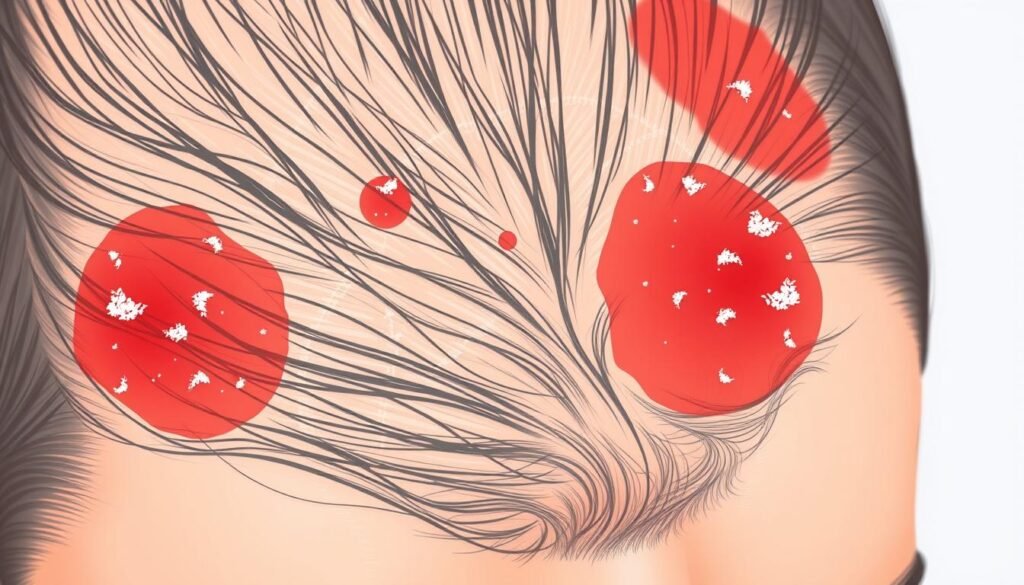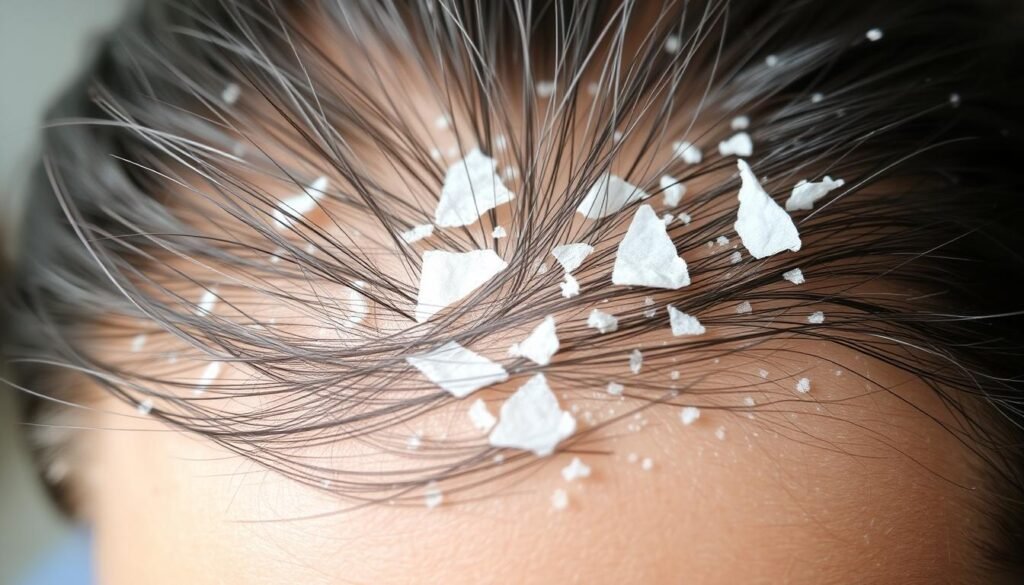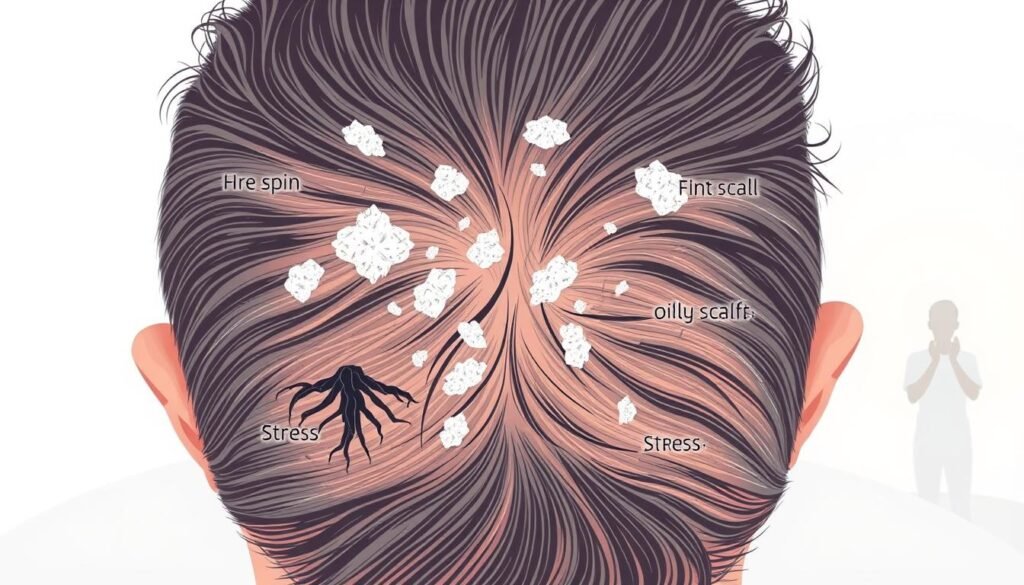Did you know about half the people have issues with Malassezia globosa on their scalp? This often leads to dandruff, a common but annoying problem. Even though this fungus naturally lives on our skin, too much of it can harm our scalp health. It can cause itching, flaking, and irritation. Knowing more about Malassezia, how it causes dandruff, and how to treat it can really help your hair care routine.
When looking for dandruff treatments, shampoos with ingredients that fight fungus, like those in Head & Shoulders, are effective. They reduce Malassezia globosa, cut down oleic acid waste, and calm irritation. This guide will explain the causes of dandruff and how to deal with it. It stresses the need to understand your own risk and any other related health issues.
For more details on dandruff and how to manage it, you might like this comprehensive article.
Key Takeaways
- Malassezia globosa can lead to dandruff in up to 50% of individuals.
- Dandruff may start in young adulthood and often continues into middle age.
- Anti-dandruff products help control Malassezia and soothe the scalp.
- Males are generally more susceptible to dandruff than females.
- Health conditions like Parkinson’s disease can increase dandruff risk.
- Dry or oily skin may contribute to dandruff formation.
Understanding Malassezia Fungus
Malassezia is a type of fungus found on the skin of around 7 billion people. It helps keep the skin balanced and usually doesn’t cause harm. But, if it grows too much, it may lead to skin issues like dandruff, prompting questions about what is Malassezia.
What is Malassezia?
Malassezia is part of our skin’s natural community. It lives well in the oily parts of our skin. While not usually a problem, it can cause issues for some, especially those prone to skin conditions. Research shows that about half of adults with atopic eczema might react to Malassezia. This reaction suggests a connection between the fungus and several skin problems.
Types of Malassezia and Their Effects
Scientists have identified 14 types of Malassezia. Eight of these are common in humans. Malassezia globosa, known for causing dandruff, has a unique set of 4,285 genes. It can break down fats thanks to its lipase genes. Meanwhile, Malassezia pachydermatis doesn’t need outside fats to grow. Knowing about these Malassezia types helps in treating dandruff and similar skin issues.
| Malassezia Species | Key Characteristics | Associated Conditions |
|---|---|---|
| Malassezia globosa | 4,285 genes, multiple lipase genes, commonly linked to dandruff | Dandruff, Seborrheic Dermatitis |
| Malassezia restricta | Predominant in moderate cases of dandruff (37.8% in northern populations) | Dandruff |
| Malassezia furfur | Predominant in southern populations (46.4% prevalence) | Dandruff |
| Malassezia pachydermatis | Grows in the absence of exogenous lipid | Skin infections in animals |
The more Malassezia there is, the worse dandruff can get. This shows why it’s vital to understand the fungus for effective control and treatment.
How Malassezia Causes Dandruff
Dandruff is a widespread issue. It is caused by many factors, including Malassezia fungus on the scalp. Knowing how Malassezia causes dandruff can help tackle it.
The Role of Sebum in Dandruff Development
The scalp makes a natural oil called sebum. It keeps hair moisturized and safe. But too much sebum is a feast for Malassezia.
This fungus eats the sebum, disrupting balance and speeding up skin renewal. This quick pace of renewal causes the flakes we see as dandruff. Studies show more Malassezia on scalps with dandruff, proving sebum’s big role in dandruff development.
Oleic Acid and Its Impact on the Scalp
Breaking down sebum releases oleic acid. This can irritate the scalp, especially in people sensitive to it. They might get more inflammation and skin shedding, making dandruff worse.
Those with dandruff are often more affected by Malassezia. Using the right shampoos, like those with zinc pyrithione, can help. These manage Malassezia’s growth and soothe irritation from oleic acid. For more info on dandruff and scalp health, visit this resource.

Symptoms of Dandruff
Dandruff is a common scalp issue, affecting about 20% of people. The most seen signs are dandruff symptoms like visible flaking and an itching scalp. These problems can get worse when it’s cold or if you’re stressed. This happens because dry skin flakes more.
Identifying Flaking and Itching
Flaking shows up as white or yellowish scales on your scalp, hair, and clothes. It often comes with itching, which can make things more uncomfortable. Shampoos with ketoconazole, selenium sulfide, or zinc work well against these symptoms. It’s key to figure out why you’re flaking and how to deal with it.
Associated Conditions Like Seborrheic Dermatitis
Dandruff sometimes comes with skin conditions like seborrheic dermatitis. This causes oily spots on your scalp with yellow or white scales. Symptoms are not just flaking but also greasy areas and itching. Knowing about dandruff and seborrheic dermatitis helps in finding the right treatment. If these problems don’t go away, talking to a doctor is a good idea. For more on treating dandruff, click here or for tips, click here.

Risk Factors Associated with Dandruff
Dandruff is a common issue for many people. It comes from various risk factors. Knowing these factors helps us find out who might get it more.
Demographic Factors: Age and Gender
Age is key when it comes to dandruff. It tends to show up in the teen years. Then, it hits a high point in the 20s. After that, it usually drops, especially after 50. Men are more prone to dandruff than women. The rates are 3.0% for men and 2.6% for women. Rates differ across ethnic groups too. African Americans face it most, then Caucasians, and least in Chinese.
The Influence of Other Skin Conditions
Other skin problems can also raise your dandruff risk. If you have psoriasis, eczema, or a weak immune system, you might see more dandruff. Stress and certain health problems, like neurological issues, also play a role. Around 50 million Americans deal with dandruff. This leads to a lot of spending on treatments. Also, dandruff can really affect how you feel about yourself. This is especially true for women and the young.

Malassezia Fungus and Dandruff: Causes and Treatment
Dandruff is a widespread issue, often caused by Malassezia fungus. Understanding why it happens helps us fight it better. Learning about things like too much oil, hormone changes, and the weather is important. Knowing how yeast grows out of control also helps understand dandruff better.
Unraveling the Triggers of Dandruff
Several factors can make Malassezia dandruff worse. These include:
- Too much oil production, making the perfect place for Malassezia.
- Hormone changes that make you produce more sebum.
- Cold, dry air that can bother your scalp.
About half the people react badly to Malassezia globosa. This bad reaction often shows as flaking and itching. When Malassezia breaks down sebum, it makes oleic acid, which can cause allergies, making scalp issues worse.
Understanding Yeast Overgrowth
Yeast grows too much when there’s a lot of Malassezia, leading to dandruff. Studies show that dandruff scalps have way more Malassezia. This causes more skin cells to shed, making flakes more visible. Products like Head & Shoulders are made to fight Malassezia and its effects. They help keep your scalp healthy and comfortable.
Dandruff is more common in those with more sebum, often seen in males. Keeping dandruff in check usually means using anti-dandruff shampoos regularly. This helps keep the scalp’s environment stable.
| Trigger | Effect on Dandruff |
|---|---|
| Excessive Oil Production | Creates a favorable environment for Malassezia growth |
| Hormonal Changes | Increases oil secretion, exacerbating dandruff |
| Cold, Dry Air | Irritates the scalp and worsens symptoms |
| Yeast Overgrowth | Increases skin cell turnover and flaking |
Effective Treatment Options for Dandruff
Dandruff affects nearly half of the people worldwide at some point. Finding the right treatment is key to controlling it. Treatments range from simple store-bought options to complex formulas tackling the root cause.
Choosing the Right Antifungal Shampoo
Picking the correct antifungal shampoo is vital for fighting dandruff. These shampoos often have ingredients like:
- Ketoconazole – Targets Malassezia fungi effectively.
- Selenium sulfide – Reduces fungal growth and helps eliminate flaking.
- Zinc pyrithione – Known for its broad-spectrum antifungal properties.
- Salicylic acid – Helps reduce scaling severity.
- Tea-tree oil – Offers antifungal and antibacterial benefits.
For tough dandruff, medicated treatments often work best. It’s found that shampoos with salicylic acid outperform others, easing flakiness more effectively.
Medicated Treatments Available
When regular shampoos don’t work, medicated treatments can help. These include:
- Prescription-strength antifungal shampoos.
- Topical treatments for Malassezia overgrowth.
- Medicated lotions or creams to soothe inflammation and irritation.
Adding omega-3s and probiotics to your diet may also improve dandruff control. Studies show probiotics cut down on dandruff. Managing stress helps too, as it can trigger dandruff.
Top Natural Remedies for Dandruff Management
Looking for dandruff solutions can be tough, but natural remedies are a good path. They don’t just ease symptoms; they also make your scalp healthier. Using essential oils and home treatments is key for dandruff control and a healthy scalp.
Essential Oils and Their Benefits
Essential oils are great for dandruff management. Tea tree oil, for instance, has antimicrobial properties. It can lower dandruff by up to 41%. Lavender oil smells good and can calm your scalp, reducing swelling. Other helpful oils include eucalyptus, with its anti-inflammatory and antifungal traits, and lemongrass oil, which significantly reduces dandruff.
Home Remedies That Help
There are many home remedies that fight dandruff besides essential oils. Apple cider vinegar is a top pick because it fights fungus. Mixing it with water and applying it to your scalp can decrease flakes. Aloe vera helps with its antibacterial and anti-inflammatory abilities. It calms irritation and improves scalp health.
Eating foods rich in omega-3 fatty acids keeps skin moist and lowers swelling. Washing your hair often and massaging your scalp with natural products also helps a lot. This approach to scalp care makes treatment more enjoyable.
Daily Hair Care Tips for a Healthy Scalp
A healthy scalp is key for good hair growth and quality. A good Hair Washing Routine boosts Scalp Health. We’ll show you how to create a routine and how styling products affect your scalp.
Creating a Balanced Hair Washing Routine
Knowing your hair type and scalp condition is the first step. Greasy hair might need washing every other day. People with finer hair could be okay washing twice a week. Use lukewarm water (about 40°C or 100°F) to keep your hair’s natural moisture.
Look for shampoos with ketoconazole, zinc pyrithione, and aloe vera. They’re great for your scalp. Washing your hair regularly prevents buildup and dandruff. For more tips on a healthy scalp, visit this resource.
Styling Products and Their Effects on Scalp Health
Using Styling Products too often can cause scalp problems. Choose products that don’t block pores. Tea tree oil can help fight fungus and relieve itchiness, keeping your Scalp Health in check. Using fewer products helps maintain your scalp’s balance and improves hair health. Picking the right products is crucial for a healthy scalp.
| Hair Type | Washing Frequency | Recommended Ingredients |
|---|---|---|
| Greasy Hair | Every other day | Ketoconazole, Zinc Pyrithione |
| Weak Hair | Twice a week | Aloe Vera, Coal Tar |
| Normal Scalp | Thrice weekly | Tea Tree Oil, Selenium Sulfide |
When to Seek Professional Help
Dandruff can usually be managed with the right treatments. However, you may need to see a pro in some cases. If you have intense itching, bleeding, or big flakes that normal shampoos can’t fix, it’s time to get expert advice.
Signs That Indicate a Serious Issue
Watch for ongoing redness, scaly spots that ooze, or pain in your scalp. These signs may mean you have seborrheic dermatitis or another skin issue. Seeing a specialist can help figure out the best way to treat your dandruff, based on your needs.
Consulting a Dermatologist
If your dandruff is really bad or won’t go away, talk to a dermatologist. They know all about conditions like seborrheic dermatitis. They might prescribe medicine or special treatments to help heal your scalp. They’ll also know which antifungal shampoos and care techniques can keep your scalp healthy and comfy over time.